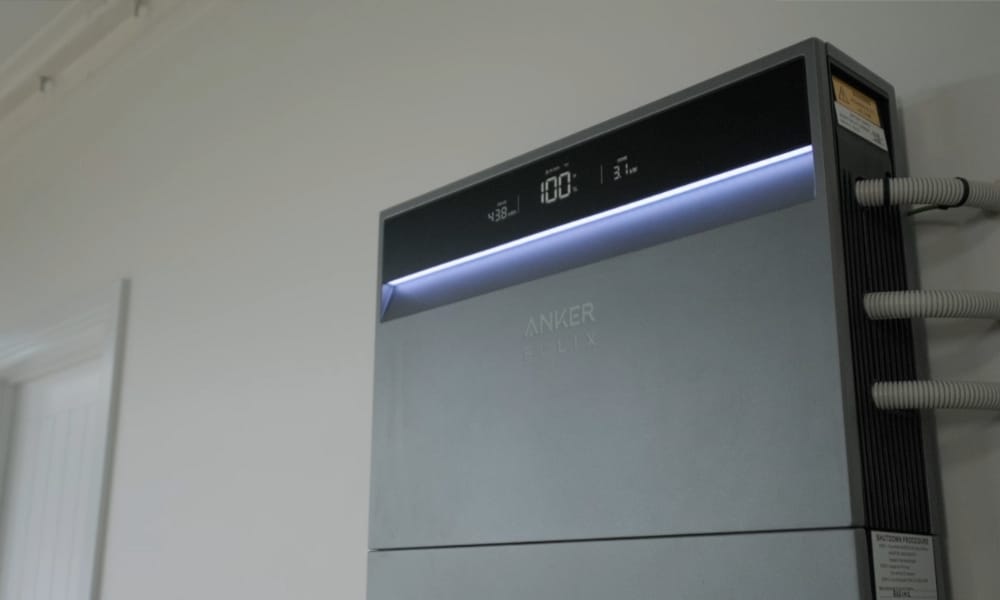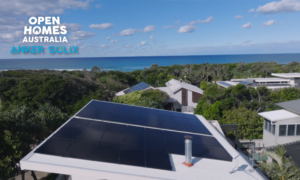In the age of rising power prices, unpredictable weather, and fragile grid infrastructure, battery storage is no longer a luxury. It’s a necessity. And for many Australians, backup power during blackouts isn’t just about keeping the lights on. It’s about keeping life moving.
Enter the Anker SOLIX X1 – a sleek, modular hybrid battery system designed not just for energy savings, but for serious energy independence. As seen in Episode 8 of Energy Matters.
When backup power becomes peace of mind
Blackouts are becoming more common across Australia. From summer heatwaves to east coast storms, grid reliability is patchy at best. And as RESINC’s Leigh Storr pointed out in Energy Matters, some Australians are left without power for days, not hours.
That’s where battery backup becomes less about return on investment and more about quality of life.
Phil Krok, Sales Manager at Anker SOLIX, knows this first-hand:
“I had a blackout… streaming Netflix just stopped. That’s how I realised we’d switched to off-grid mode. It was seamless.”
It’s that seamlessness that makes the X1 stand out. As Krok explains in Episode 78 on the Road to ZERO Podcast,
“The lights on the battery change colour when you switch from grid to off-grid. You drive into the garage and just know you’ve got power, even if the street’s blacked out.”
Energy independence isn’t a trend, it’s a strategy
Battery storage is often compared to solar in its early days: early adopters were rewarded, and now over 4 million Australian rooftops have solar. But without a battery, most of that solar gets exported back to the grid for pennies.
As Krok puts it:
“Why give it back for a few cents, only to buy it back for 30 cents? That’s madness.”
Storing excess solar lets you use your own power when you need it most, especially after dark. It’s like installing a rainwater tank for your rooftop sunshine.
And now, with the federal Cheaper Home Batteries Program, it’s more affordable than ever.
A strong financial case (finally)
Until recently, batteries were the domain of the few. But with the new federal rebate, households can now access up to $370 per kilowatt-hour, slashing battery prices by up to 40%. For example:
| Battery Size | Usual Cost (Est.) | Rebate | Estimated Post-Rebate Cost |
| 10 kWh | $10,000 | $3,700 | $6,300 |
| 15 kWh | $15,000 | $5,550 | $9,450 |
| 20 kWh | $20,000 | $7,400 | $12,600 |
The scheme operates like STCs for solar – a point-of-sale discount, claimed by your installer. You only get one shot, though, so it pays to go bigger now. As Krok says:
“If you’re planning for EVs, home automation, or more appliances, get the biggest battery you can justify. You won’t regret it.”
Why the Anker SOLIX X1 leads the charge
While there are plenty of battery options on the market, few tick all the boxes like the Anker SOLIX X1. Built by consumer tech giant Anker (yep, the phone charger brand), it blends serious performance with elegant design.
“The first thing people notice is how good it looks,” says Krok. “Even the homeowner on Energy Matters gave it a hug.”
Here’s why the X1 is getting attention:
Key benefits:
- Modular design: Start at 5 kWh and expand to 180 kWh
- Blackout protection: Instant switch to off-grid mode with visual indicators
- Built-in screen: Live stats at a glance, no app needed
- Hybrid or AC-coupled: Suits both new and retrofit installs
- Garage-ready aesthetic: Slimline, modern, no ‘white box’ eyesore

Anker SOLIX X1 specs:
| Feature | Detail |
| System Type | Hybrid or AC-coupled |
| Battery Capacity | 5–180 kWh (modular in 5 kWh units) |
| Output | Up to 15 kW (3-phase) |
| Blackout Protection | Yes (with backup circuits) |
| Expandability | Up to 6 modules (30 kWh per stack) |
| Monitoring | Built-in screen + app |
| Warranty | 10 years |
| Installation Location | Indoor/outdoor, garage-friendly |
It’s not just about savings
Sure, a battery will cut your bills further. But the true value lies in resilience.
It’s not just about cost savings, it’s about lifestyle continuity during blackouts. Protecting your food, keeping your devices charged, and staying comfortable when the grid goes down is what makes backup battery systems a smart long-term investment.
That peace of mind is why more Australians are pairing solar with batteries like the X1, especially when it’s modular, scalable, and easy to install.
Act now: The rebate clock is ticking
The Cheaper Home Batteries rebate officially started on 1 July 2025, but stock is already tight. Krok warns that demand will surge:
“Installers will be flat out. If you can install now, do it.”
And with 30–40% discounts on offer, Aussies finally have the chance to take full control of their energy, without breaking the bank.
Want to learn more about the Anker SOLIX X1?
Watch Energy Matters Episode 8 on 9Now and explore the products and their features, and even request a FREE quote, on our Anker SOLIX page.
If you’ve got solar, a battery is your next logical step. And if you value independence, blackout protection might just be priceless.














































